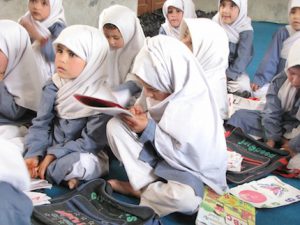Until a decade ago, the only snow leopard a resident of Pakistan’s Basha Valley wanted to see was a dead one. But today the endangered big cat has brought education to their homes, especially to their daughters.
Tanya Rosen, a snow leopard conservationist, was on one of her expeditions in a village called Sibiri in the valley in 2010. She found that none of the village girls were enrolled in school.
Basha Valley is in Baltistan, in the Karakoram range of the Hindu Kush Himalayas, bordering Xinjiang, China.
“I saw all these cute little girls watching us through the windows and it struck me that these girls should be in school, instead of peering at us from their homes. I asked around and learned they were not because their parents were too poor to afford books, uniforms and even shoes,” she told me over email from Tajikistan, where she works for Panthera, an organisation dedicated to ensuring “a future for the wild cats of the world.”

Doing some quick back of the envelope calculations, Rosen figured out it would take “only US$2,100 to fund fees, uniforms, books etc., for a year for all the 67 out-of-school girls.”
Without hesitation, she told Ghulam Muhammad of the Baltistan Wildlife Conservation and Development Organisation (BWCDO), who was accompanying her, that she would arrange for the money.
Her daughter, Bianca, just seven then, was her first donor.
“Our support showed that as snow leopard conservationists we cared about the communities and their livelihoods first,” pointed out Rosen. This was important, because the average villager sees the snow leopard as a sheep killer.
But Sibiri was not the only village where girls were not going to school. There were villages across the region where most girls were out of school. Rosen found out that even when schools existed, “there were no teachers or education was only offered to boys.”
The same year, she found out about educationist Genevieve and her mountaineer husband, Doug Chabot, who wanted to set up an organisation focused on providing access to high quality education for girls in Gilgit-Baltistan. Rosen informed them about the out-of-school girls in Basha valley, an area where BWCDO was working too.
There has been no looking back for either Rosen or the Chabots since then. Covering 12 villages, today 559 girls and 158 boys are enrolled in various schools. The Iqra Fund, founded by the Chabots, has hired 20 teachers.

According to Shafqat Hussain, a conservationist, who founded the Project Snow Leopard in Basha Valley, and has been working in the region for two decades, the community is very poor – living on subsistence farming and rearing livestock. “Where an average family size is nine or ten, and resources stretched, terrain difficult to traverse, the closest government school hours away, even if parents want to educate their children, it remains a pipe dream,” he said.
He feels there are so many areas that the villagers need to be supported in. But his hands are tied. “We work in the area of conservation and we cannot stop our work and decide to address other problems because they exist,” he said, emphasising that it was not a matter of “lack of knowledge” that the needs of the communities were not addressed but more because he “didn’t have the resources and expertise to do that.”
Villages support snow leopard conservation
Back in 1999, Hussain, then professor of anthropology at Trinity College in the US, had initiated an innovative insurance project in two villages in Baltistan, with funding from Britain’s Royal Geographical Society and the US-based Snow Leopard Conservancy.
The project has since expanded to cover 22 villages. It not only helps protect the endangered cat but compensates the local herders for every goat killed by it, on condition that the villagers will not resort to retaliatory killing. From 2006 to 2012, they have paid compensation for 206 animals killed by snow leopards.
“There are about 1,500 to 1,600 households in these villages of which 40% have insured their animals; there is still a vast majority that we have been unable to bring in as they cannot afford to insure their animals,” said BWCDO’s Muhammad.
The success of the project can be gauged by the fact that it is now being replicated in China, India and Nepal.
The experts in the organisation Panthera estimate there are anything between 3,500 and 7,000 snow leopards living in the wild today, spread across 12 countries in Asia, most of them in the Hindu Kush Himalayas. The species, Panthera uncia, is the toughest of the big cats to spot, as they live and travel along steep mountain slopes, usually staying between 3,000 and 5,400 metres above sea level.
Snow leopards are endangered as their furs are highly prized in the illegal wildlife market, because shepherds are often in conflict with the animals, and because their ranges are getting fragmented, sometimes for farming and sometimes by shepherds.
Based on a survey he conducted in 2003, Hussain estimated there were anything between 250 and 450 snow leopards in Pakistan, spread across Chitral and Gilgit-Baltistan; in the Dir, Swat and Kohistan districts of Khyber Pakhtunkhwa province; and in Muzaffarabad in Pakistan-administered Kashmir. A fresh survey has just been done, and the results are being tabulated.
The conservationists will be able to gauge if their intervention has helped safeguard the snow leopard, which they fondly call the “mountain ghost”.

